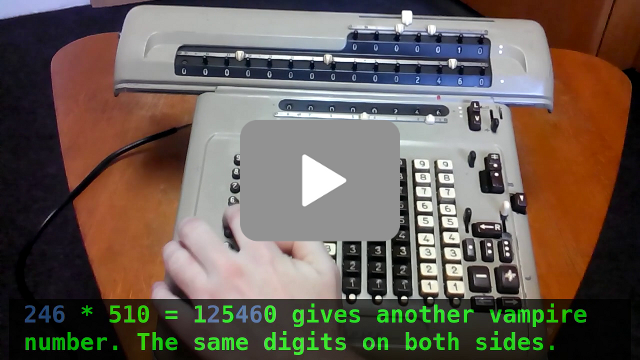Diehl KR15 calculator
The video contains
- basic facts on Diehl KR 15
- semiautotmatic multiplication with some funny numbers
- full automatic division with possibility to preset the precision
- computing with and without the covers
- nice music from free Youtube library
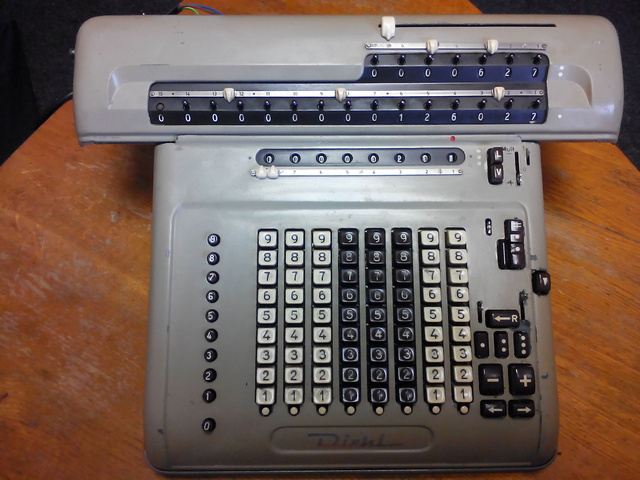
Diehl is a continuation of Archimedes line of calculators. Archimedes company produced their calculators in Glashütte, Germany. After WWII the company was located in the eastern part of Germany, future DDR. The management and leading developers of the company moved to Nürnberg in the western part, future BRD, and continued the production under the wing of the Diehl concern.
Thanks to the advanced know-how from Archimedes time, Diehl become fast to be one of the prominent producers of the electromechanical calculators. The strongest competitors who produced machines of the same type were in 50's and 60's Friden, Marchant and Monroe from USA and Madas from Switzerland. Two other strong competitors, Rheinmetall and Mercedes, were located in DDR and produced mainly for the market in Soviet communistic block. A minor competitor in Germany was Badenia in St. Georgen (Schwarzwald). The other producers like Facit, DeTeWe (Hamann) or Brunsviga also produced electromechanical calculators, but of a slightly different class.
The model KR15 has been produced from 1960 to 1964. It is a stepped drum calculator which is a redesigned model DR produced from 1957 to 1959.
The calculators were that time real wonders of fine mechanic. They were also very expensive. The first (simplest) Diehl calculators were assembled from about 2800 parts, all of them produced in Nürnberg. The number of components for advanced model attacked the number 4000. The price corresponded with the fact that the calculators were one of the peaks of technology and fine mechanics that days. The prices of electromechanical calculators that time are unbelievable comparing to prices of present calculators and computers. The buyers paid from 2500 to 4000 DM for one Diehl calculator! For basic comparison: the price for the car VW that time was 4150 DM, the average monthly income was 400 DM.
Merits of KR15
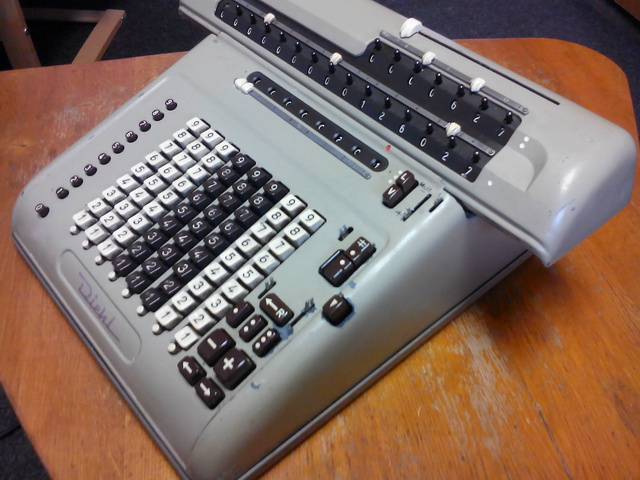
The calculator Diehl reminds Friden or Monroe calculators. It has a full keyboard which was very smooth comparing to the keyboards of other producers. Just a light press was sufficient to press any key.
The calculator allowed the multiplication as a repeated addition or subtraction. The line of keys on the left was used for this purpose. The user entered the first factor to be multiplied on the keyboard. Then pressed the key from the multiplication line and the number from keyboard has been repeatedly added to the main register, according to the key pressed. When the addition was finished, the carriage moved one position to the right. This could be followed by pressing another key from the multiplication line. Consequently, one of the factors was on the keyboard and the second has been entered in the multiplication line on the left from the last digit to the first one.
If a digit $n$ bigger than 5 has been pressed, then a shortcut multiplication has been used rather than to add $n$-times the number from keyboard. The machine subtracted the number $10-n$-times, moved to the next position and added once. This caused that the $n$-multiple of the number from the keyboard has been added to the main register using $11-n$ operations of addition or subtraction. Thus for $n>5$ the operation went through faster. As a particular example, to multiply by 9 it is not necessary to do nine addition cycles, but just one subtraction and one addition cycle.
The mechanism for a shortcut multiplication is described in US Patent 2215263. A related patent is also US 2969911 which is closer to the mechanism used in KR 15 model. There was also another line of calculator, with small letter "s" in the name, which allowed to enter the second factor from the first digit to the last and not from the last to the first one, as for KR model.
The multiplication described here has been used also in some Marchant calculators. But here it is worth to mention, that the addition and subtraction was much faster on Marchant, than on other calculators. The method of multiplication has been improved in the fullautomat V15 (produced from 1957 or 1959) where the user entered all digits of the factor in a special memory, then entered the second factor and initiated the multiplication. The procedure was not faster than on KR15, but more comfortable to the user.
Another feature of Diehl KR which was not typical for all machines of this class was the presence of the tabulator for division. It was located above the counter of revolutions. This tabulator allowed to set how many digits of quotient have to be computed.
The keys
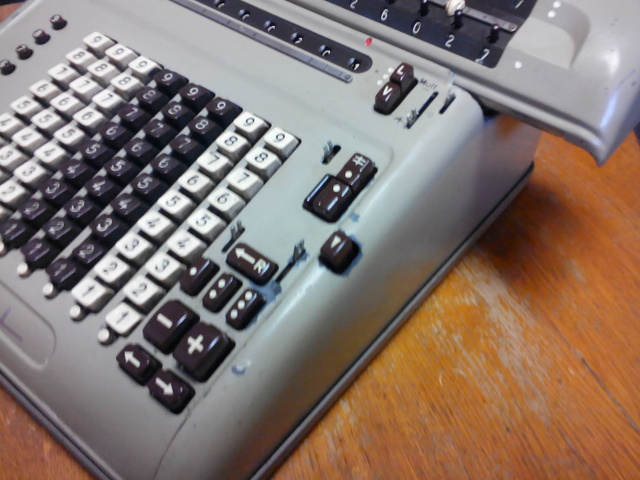
The keys in the leftmost multiplication column were discussed in the previous paragraph. The function of the number keys on the main keyboard in the central part is clear without any explanation. The other function keys are located on the right. Without the manual I tried to determine the keys using trial and error method. From bottom up we have the following keys
- arrows to shift the carriage left or right
- plus and minus key to add or subtract the number from keyboard
- keys for clearing registers and keyboard
- R key to return the carriage to the basic position
- the key with triangle down blocks the machine (this was probably not intended behavior of this key)
- the button with dot initiates the division
- the button above (with dot and inequality sign) reverses the counter of revolutions and is used usually with the button for division
- the V button is used to enter dividend for division -- moves the carriage to the appropriate position and adds the number from keyboard.
- the L button works like the V button, but clears registers first.
The following levers have been used to govern the computation.
- If the lever on the left of R key is up, then the counters are reset before moving the carriage to the basic position.
- The lever on the right of R key switches on or off the automatic clearance of the keyboard after addition or subtraction. The position of this lever is adjusted automatically, if the multiplication key from the leftmost column is pressed.
- The lever on the left of division key can be used to interrupt the division as soon as the digit on the current position is computed.
- The levers on the right of LV buttons are used for negative multiplication (the multiple is not added but subtracted from the result register) and to disconnect the counter register.
Division has been performed in the following steps
- enter the dividend on the right (not left) of the keyboard
- set the tabulator for the division and press L or V button to transfer the dividend to the result register
- enter the divisor to the right part of the keyboard
- press the two buttons with dot to initiate the division
- the result appears in the quotient register.
The quotient is determined using oscillating division, i.e. the cycles of repeated subtraction are followed by the cycles of repeated addition.
What is interesting on the computations in the video
I used a brute force algorithm to found out the following facts related to a product and powers of numbers. Some of htem are used as a demonstration of multiplication capabilities of the calculator.
If I have mistaken somewhere on the hunt for these interesting facts and something is not true, please, let me know :)
Pandigital numbers
- The number $923187456$ is the largest number which can be obtained as a permutation of digits from 1 to 9 and it is a square. We have $$30384^2=923187456.$$ Another example is $$24441^2=597362481. $$
- Only two squares which can be obtained as a permutation of digits from 0 to 9 are generated by numbers constituted from two (repeating) digits. One digit is not enough for this task. $$97779^2=9560732841$$ $$67677^2=4580176329$$
- Among all squares which are a permutation of digits from 1 to 9 only one arises as a square of 5 consecutive digits $$12543^2=157326849.$$
- Among all squares which are a permutation of digits from 0 to 9 only one arises as a square of 5 consecutive digits $$46587^2=2170348569.$$
Vampire numbers
Definition:: In mathematics, a vampire number (or true vampire number) is a composite natural number $v$, with an even number of digits $n$, that can be factored into two integers $x$ and $y$ each with $n/2$ digits and not both with trailing zeroes, where $v$ contains precisely all the digits from $x$ and from $y$, in any order, counting multiplicity. $x$ and $y$ are called the fangs.
Let us hunt for vampire numbers among the dates of the current year, 2016. The months are 1,2,3, etc, i.e. not 01, 02, 03, ... The same arrangement will be used to represent days by numbers. There is no date which corresponds to the vampire number, but let us allow the permutation of the numbers
- The first permuted vampire day in the year 2016 is February 7, 2016. Really, using the digits 272016 we have $$201 \times 627 = 126027.$$ There are the same digits on the left and on the right side of this equation.
- The first permuted vampire day without repeating digits is April 5, 2016. Here we have (using digits 452016) a vampire number with two pair of fangs, really $$246 \times 510 = 125460 $$and$$ 204 \times 615 = 125460.$$ Moreover, using the same digits we have $$240 \times 651 = 156240$$ and $$204 \times 516 = 105264.$$ In all cases the same digits are used on the left and on the right. Note that the number $204$ appears as fang in two computations.
- The last permuted vampire date in 2016 is the Christmas day, December 24, i.e. 24.12.2016. We have $$4221 \times 6210 = 26212410.$$
The following poor man's script has been used to find these dates
# Script finds the days in from January to December 2016 whose digits
# form the vampire number:
# https://en.wikipedia.org/wiki/Vampire_number
import itertools
for j in (1,2,3,4,5,6,7,8,9):
for i in range(1,10):
numbers=list(itertools.permutations([i,j,2,0,1,6]))
test=sorted(str(i)+str(j)+"2016")
for number in numbers:
a=number[0]*100+number[1]*10+number[2]
b=number[3]*100+number[4]*10+number[5]
current=sorted(str(a*b))
if test==current and a<=b:
print "Month "+str(j)+" day "+str(i)+", 2016:",a,"x",b,"=",a*b
for j in (10,11,12):
for i in range(10,32):
numbers=list(itertools.permutations([i/10,i-i/10*10,j/10,j-j/10*10,2,0,1,6]))
test=sorted(str(i)+str(j)+"2016")
for number in numbers:
a=number[0]*1000+number[1]*100+number[2]*10+number[3]
b=number[4]*1000+number[5]*100+number[6]*10+number[7]
current=sorted(str(a*b))
if test==current and a<=b:
print "Month "+str(j)+" day "+str(i)+", 2016:",a,"x",b,"=",a*b
Other funny products
Let us build a 5-digit number from odd digits 1,3,5,7,9, and another 5-digit number from even digits 0,2,4,6,8 and let us multiply them. You always need at least three repeating digits to write the result. Altogether 14 results have this property, the other results need at least 4 digits. The most pleasant one is the following $$ 40826 \times 13597 = 555111122 $$ On the other hand, there are 15 possibilities how to obtain all digits from 1 to 9, with possible repeating digit. The smallest one is $1352854976$ and we have $$26048 \times 51937 =1352854976.$$ And $30693^2$ is a palindrome since $$30693^2= 942060249.$$
For fun, Python code like this can be used to find pandigigal numbers and palidromes among powers and sum of powers.
for i in range (10,200000):
test=((i,i*i,"square"),(i,i*i*i,'cube'),(i,i+i*i,"number plus square"),(i,i*i+i*i*i,"square plus cube"),(i,i+i*i+i*i*i,"number plus square plus cube"));
for testovane in test:
if str(testovane[1])==str(testovane[1])[::-1]:
print "Palindrome: ",testovane
if "".join(sorted(str(testovane[1])))=="0123456789":
print "Pandigital, no redundand: ",testovane
#elif set(str(testovane[1]))==set(str(1234567890)):
# print "Pandigital: ",testovane
if "".join(sorted(str(testovane[1])))=="123456789":
print "Zeroless pandigital, no redundand: ",testovane
#elif set(str(testovane[1]))==set(str(123456789)):
# print "Zeroless pandigital: ",testovane
#jstr=''.join(sorted(str(j)))
#print ""+str(i)+" : "+jstr+" , "+str(j)+" "+" ; "+str(len("".join(set(str(i)))))
What is inside
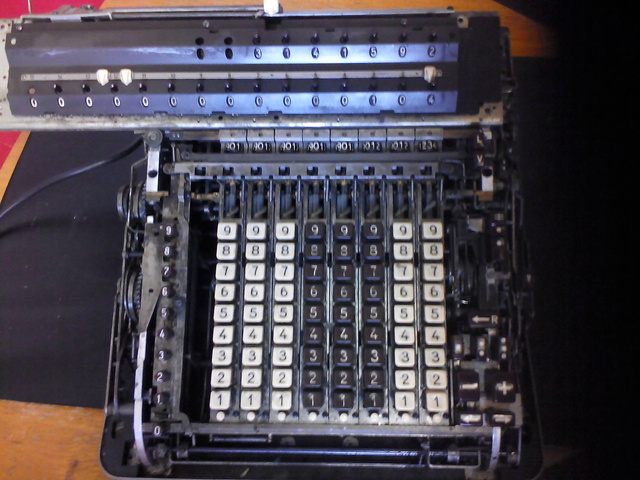
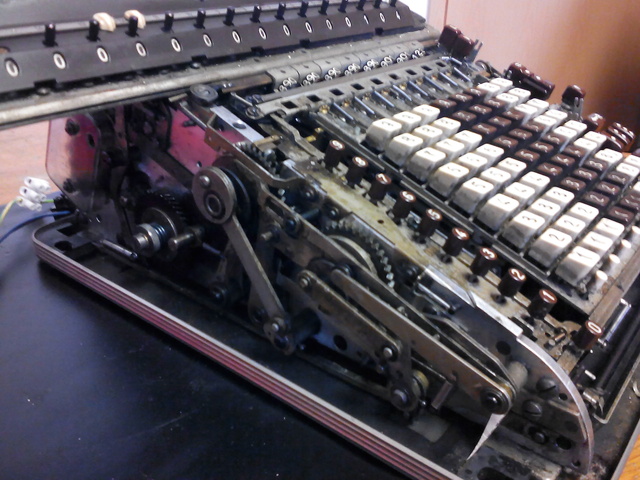
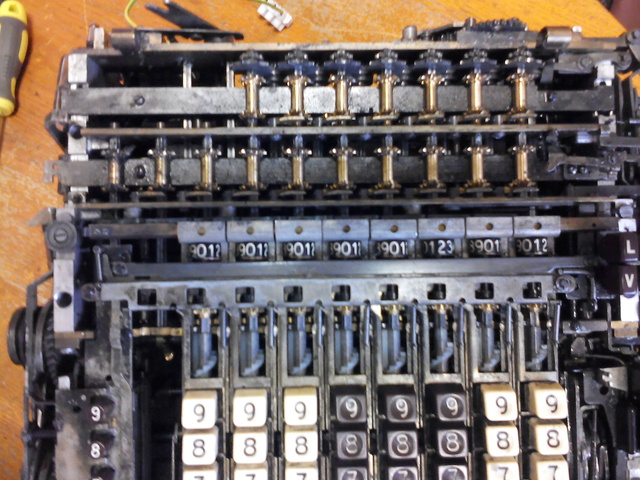
The impression from the machine would be very poor for any calculator lover if he or she is not allowed to have a look under the covers. You can remove the covers in the following steps
- Remove the rod which fixes the carriage. Press the lever on the rear side of the carriage and pull the rod out.
- There are eight screws on the bottom side of the calculator. Remove the four bigger screws (the bigger screws attach the cover to the bottom part, the smaller ones attach the bottom cover of the calculator to the main skeleton)
- Remove the cover by lifting it up.
- You may remove the cover of the carriage by removing six screws from the bottom of the carriage.
- Return the carriage to the main body. Move the handle which is at the back left (tabulator stop for division) to the left side, lay the carriage to the main body, find the appropriate position and return the rod which fixes the carriage.
On the left side you can find the small gear from the motor. This gear is connected to a bigger gear which has a spring attached. This device protects the mechanism of the calculator, if the calculator is blocked. Really, if the gears are blocked by some reason, the skew teeth cause that the gear from the motor is detached from the next gears temporarily. The strong spring attaches them again. If the calculator is blocked, the gears are disconnected and connected again and again and the user can head loud annoying knocking, reported also by many people who want to sell the Diehl calculator on eBay or other similar site.
If you want to remove the motor for inspection (or to get access to the RC filter attached to the switch), there are two screws under this gear with a spring. But even if you remove the screws it is still quite interesting puzzle how to get the motor out of the calculator :). And remember to return all the pads on their place when you put everything together again.
You may try to move the gear by your hand. In my calculator, the gears can be moved easily if I add or subtract and the moving is very hard if the carriage shifts. The motor runs always the same direction. This is the same as for the Mercedes Euklid calculators and different to Brunsviga 11s. The fact that the rotation of the motor is always the same allows to have a simpler arrangement of the electric part of the machine, but needs some additional mechanical devices to differentiate between addition and subtraction.
Restoration story
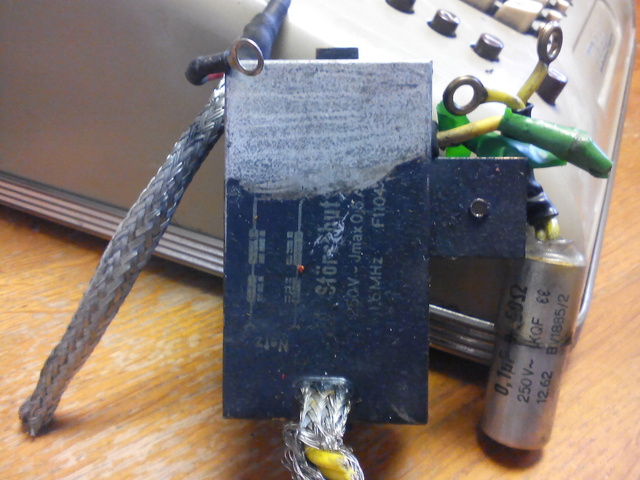
I got the calculator for a little price, but it did not work. On the web I have found an information that a maloperation could damage the whole device. This seems to be supported by the fact that most of the Diehl calculators sold on eBay are reported not to work (loud knocking from inside). However, the US patent reports Diehl as a foolproof calculator.
I am pleased to announce that I succeeded to make the calculator work. I think that the main problems of Diehl calculators are degraded capacitors (see the story below).
I would like to emphasise, that my main target was to make the calculator work and see in action its unique method of multiplication. Many other people achieve prefect clean look of their machines and the calculators shine fantastic. This certainly needs a lot of time and effort and could be my future mission. Maybe after my retirement (which will be realized more than 20 years from now).
During the restoration I faced the following problems.
The calculator was dirty
I dared to disassemble the calculator too much if not necessary. Therefore I used petrol and fine brush to clean the internal mechanism. I used Konkor (oil used for example to conserve guns) to movable parts. Some of the parts were still sluggish and I decided to use WD40 to improve. Remembering that WD40 glues the parts together after months, I did my best to remove the residuals of WD40 by petrol and replaced by Konkor.
The calculator was blocked
I succeeded to unblock the calculator by randomly using screwdriver and trial and error method. I pushed levers and various parts of mechanism, mainly on the left of the number 6 in the multiplication line and above the R key. Also it was necessary to push something near the line of the display attached to the keyboard.
The filter burned
When playing with the calculator, the filter attached to AC to prevent electromagnetic disturbance burned (not in flames, but with a lot of smoke). Note that prof. Hamann reported the same problem with another his calculator. His solution was to replace by a modern universal type. My solution (short time) was to remove the filter and use calculator without this filter. This could be done for testing purposes, since nowadays nobody listens radio on MW (perhaps just some fans of old radios?). Long term solution is to replace by a modern filter or at least (cheap option) a capacitor attached to the motor.
The motor was running forever
The motor did not stop after the calculation. The switch did not move. The solution was to use petrol to clean and Konkor to oil the parts which are responsible to turn the switch on or off. However, this did not solve the problem, the motor still worked even if the switch was off. The problem was in the serial RC filter which is attached parallel to the switch. The filter was broken. To remove the filter from the calculator you have to remove the motor first (remove one gear which hides two screws and then solve a brain tester), but you can keep the filter on its place and jut disconnect from the switch. (Just two components are attached to the switch, the motor and the RC filter. Even in the worst case you have 50:50 chance that you disconnect the right thing.) The short term solution is to try the calculator without this filter. It works and I cannot see sparks at the switch. However, a better solution is to use the new RC filter of (much cheaper way) to use resistor and capacitor. You can see the values for the components on the picture, but I think that you can use some universal values, like 220nF for capacitor and 220 Ohm for the resistor.
The keys which move carriage are lazy and do not return to the main position
If the keys which move the carriage were pressed, they did not return to their main position automatically. By pressing one of these keys, the carriage was moved to the leftmost or rightmost position. Among others, this made multiplication impossible. I used a lot of WD40 to let the parts to move better. Then I used a lot of petrol and oil to remove the WD40. After this the keys move better but still not perfect. I observed that if the key is not pressed too much, it returns to the main position as it should. I faced two options to chose from:
- either to disassemble the mechanism and find and fix the problem
- or to use something which prevents the keys from being pressed too much.
I used the second option and a piece of cardboard solved the problem. A lot of oil remained on the mechanism from this operation. Oil makes the parts movable by smaller friction, but attracts dust. So the condition of the calculator will become worse and worse as time is running. For now I protected the calculator with a cover. I hope that this is enough to resolve the issue with oil and dust. The next 15 years will confirm or disprove this expectation.
General hints for restoration
Many authors wrote excellent guides for the people who try to repair the mechanical or electromechanical calculator
- John Wolf gives many general remarks and also detailed instructions. Excellent reading but covers mostly mechanical models.
- Christian-M. Hamann describes also some general methods as well as more or less detailed story related to many particular models from his Online Museum
- Wim Hasselo gives some useful advices on electromechanical calculators and the technology behind - go to his pages, the section Technical miscellaneous, Electric drive.
- And if you buy the calculator and want to give to the seller the instructions how to pack, you may use the excellent survey by Cris Vande Velde.
Here you have also some notes from me. I will describe what to do with new calculator if you want to test it with a minimal effort.
- It is a good idea not the plug the machine to the electricity immediately when you got the calculator. Open the cover and look inside. Inspect by your eyes the wires and the inside of the calculator. Replace the wires if they are not in good condition.
- Using an ohmmeter (multimeter) measure the resistance of the calculator when it is on and off. Ensure that the is no short circuit inside (the resistance should not drop too close to zero). Measure the resistance between the main wires (AC plug) and the cover to ensure, that no electricity appears on the cover (the resistance should be infinity in this case).
- Using ohmmeter check, that the calculator is grounded properly (zero resistance between the cover and grounding pin).
- Move the motor by your hand first (or pliers or homemade crank or other tool). This saves the mechanism from strokes if the calculator hangs for some mechanical reason.
- Check that the capacitors are in good condition. First of all, you may check that there is no short circuit inside (no zero resistance). Here is one hint how to check capacitor without special devices: You may connect the capacitor in a series with a bulb (25-60W) and plug into 220V. The bulb should shine, but less than without the capacitor. You should know what you do and be careful enough! Do not do this unless you are skilled in electric circuits.
- With an old device, it is a god idea not to plug directly into 220V. Some people start at lower voltage and increase up to 220V. If the machine behaves bad, they stop and fix the problem. This needs special equipment, but some fans or old radios do the following trick: they try the machine (radio in their case) in a series with a convenient bulb first. This should prevent the old capacitors from damage. However, I cannot support this by more advanced arguments or statistics.
- Another good idea, which can be used for cheap models if something does not work, is to find two calculators of a similar type. They will be similar also inside. If you do not know how to fix some thing on the first calculator, you can look at the other one and hope that you find out how this or that could be fixed.
Final remarks
The main problems with this calculator were caused by degraded capacitors in filters. The story has been described above. These capacitors are not vital. The calculator may work even without them and they can be replaced for a small price.
I have also another Diehl calculator (DS18) which suffers from the same problems with capacitors. However in this case another capacitor is attached also to the speed regulation. The short circuit in this calculator causes that the speed regulation does not have any effect and motor runs at a high speed. The calculator get blocked even after a simple operation. Moreover, perhaps this high speed is a source of slight deformations in the computing unit. It will be my next project to fix these problem and repair the Diehl calculator with mechanical memory :) The electric scheme of DS type is more complicated than KR, since instead one RC filter at the switch we have more RC filters and also some RLC filter (where the coil burned in flames and smoke). This will be discussed in a subsequent article.
Call for additional resources
The literature related to the Diehl electromechanical calculators is much rare comparing the literature devoted to other types. Among others, there is no manual on the Internet, no video with Diehl calculator on Youtube and no service manual or adverts. If some fan of these calculators is able to complete the information from this article, I will be pleased to add your remarks and comments or links here. Just send me an email (robert.marik.cz at gmail.com or marik at mendelu.cz). I will be happy to hear some news about this excellent production line of electromechanical calculators.
Literature
- Few remarks on technikum29
- Diehl page on Rechnerlexikon
- Few remarks on Rechenmaschinen Illustrated
- Museum für historische Wehrtechnik
- Photos of another nice Diehl calculator on Rechnerlexikon
- Patent US 2969911 which describes the multiplication
- Von der Kunstschmiede zum Technologiekonzern Diehl
Robert Mařík, March 2016
